Hesperian Health Guides
Chapter 21: Tuberculosis of the Backbone: Pott’s Disease
It is important to recognize and treat it early, before damage to the backbone causes nerve damage and paralysis.
 |
| As the spine collapses forward, the child may have to hold himself up using his arms. |
If a child begins to develop a sharp bend in the middle section of the backbone, with shortening and thickening of the chest, it is probably tuberculosis of the spine. You can almost be sure it is, if someone in the family has TB of the lungs.
Seek medical help quickly. Skin test, X-rays (of the chest and spine), and microscope examination of pus from abscesses (pockets of pus) may help in the diagnosis. If the X-ray shows typical bone destruction, the child should be treated for tuberculosis even if no TB germs are found.
Treatment
- Use several TB medicines for at least a year, as for TB of the lungs (see Where There Is No Doctor, p. 180.)
- A back brace may help keep the spine straighter. It can be made of plaster, or of plastic using techniques similar to those used for making plastic leg braces.
Or make a very simple back brace from a metal tin or drum:
| 1. Cut an oval piece from a heavy tin. | 2. Hammer the tin to fit the child’s back. Without forcing, try to put the back in the straightest position possible. | 3. Pad the tin and wrap it with a soft cloth. | 4. With an elastic bandage, bind the plate firmly to the child’s back. |
 |
 |
The child in the photo at the top of this page was effectively braced by a traditional bonesetter in this way.
- In severe or advanced cases, surgery may be needed to help straighten and stabilize the bones of the spine
Hopes for the future
With early, complete treatment the damaged bones will usually heal and the child may experience little negative impact.
If nerve damage and paralysis have begun, sometimes surgery (or even bracing during treatment) can bring some improvement.
When nerve damage is severe, rehabilitation will be the same as for spinal cord injury (see Chapters 23, 24, and 25).
Prevention consists of early diagnosis and treatment of tuberculosis, and in the fight against poverty. Vaccination against TB is also important.




